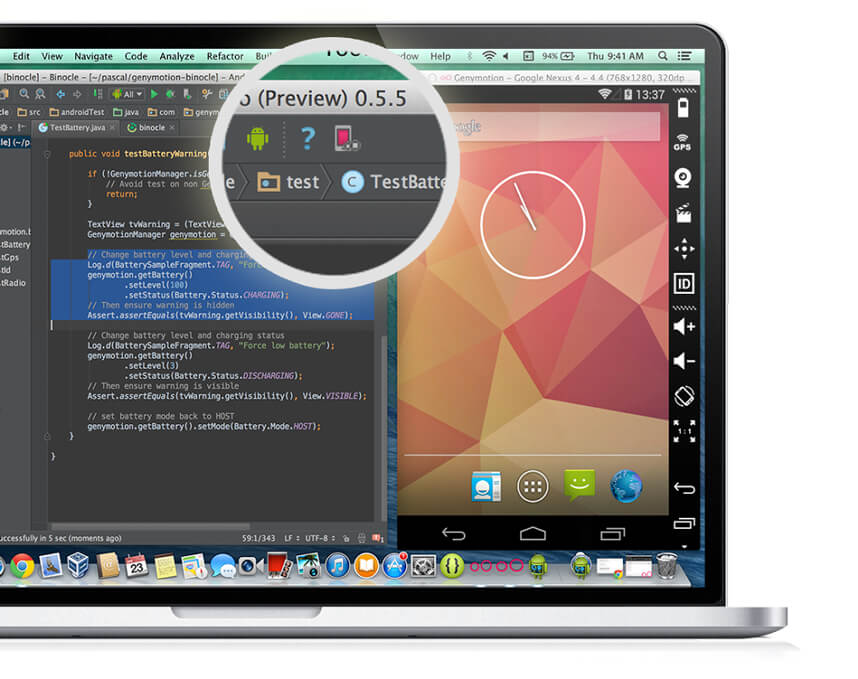The purpose of this section is to guide you to create in your development environment an Android emulator.

Android emulators are managed through a UI called AVD Manager
AVD Manager has a nice interface when started from Android Studio.
Droid4x is the best android emulator for windows and mac. It is the most efficient emulator ever made. We have solve droid4x related problems also in this tutorial. Download Real Battle Simulator for PC an android simulation game. Download Real Battle Simulator on Mac iOS & Windows Operating System for free download now. Today in this article, we discuss the download process, how to install, and run Mobile Bus Simulator on your Windows and Mac Pc. The Android Application. While Android apps are not natively supported in macOS, running Android apps on Mac is not a difficult task. Just downloading the apps won’t be enough. Before you can start running them on your Mac, you’ll need to choose and install an Android emulator. This is a piece of software that. For PC and MAC users, no need to spend for an emulator, OpenEmu, and VBA are enough, and it works for many. APK Emulator Download. You might be familiar with APK files. Most of the time, this method works but not highly recommended. However, if budget is your primary concern, head over to your favorite APK website, but proceed at your own risk.

Start Android Studio app, then create a blank project.
Go to the Tools menu -> :Android -> AVD Manager:
If no emulator has been created you should start with this screen:
Click the Create Virtual Device button.
In the Select Hardware window , select Nexus 5 as shown in the following snapshot:
Click the Next button.
In the System Image, select the system image Nougat, API Level 25 , ABI x86 :
Click on the download link to download the selected System Image. This download process is done through SDK Manager.
Once the download is complete, click on the Next button.
In the Verify Configuration window, check any parameter :
Then click on the Finish button.
AVD Manager shows you the newly created device:
Click on the launch button to launch the newly created AVD in the emulator.
Notice in the Run Window of Android Studio the command line used to start the device:
which can be shortened to :
How to start Android Emulator from Terminal?
Stop the emulator started by Android Studio. Open the Terminal app and type the following command:
This should start the emulator with the selected AVD.
References
-->This guide explains how to prepare the Android Emulator for testing your app.
Overview
The Android Emulator can be run in a variety of configurationsto simulate different devices. Each configuration is called a virtualdevice. When you deploy and test your app on the emulator, you selecta pre-configured or custom virtual device that simulates a physicalAndroid device such as a Nexus or Pixel phone.
The sections listed below describe how to accelerate the Androidemulator for maximum performance, how to use the Android Device Managerto create and customize virtual devices, and how to customize theprofile properties of a virtual device. In addition, a troubleshootingsection explains common emulator problems and workarounds.
Sections
Hardware Acceleration for Emulator Performance
How to prepare your computer for maximum Android Emulator performanceby using either Hyper-V or HAXM virtualization technology. Because theAndroid Emulator can be prohibitively slow without hardwareacceleration, we recommend that you enable hardware acceleration onyour computer before you use the emulator.
Managing Virtual Devices with the Android Device Manager
How to use the Android Device Manager to create and customize virtualdevices.
Editing Android Virtual Device Properties
How to use the Android Device Manager to edit the profile properties of avirtual device.
Android Emulator Troubleshooting
Android Simulator On Mac

In this article, the most common warning messages and issues that occurwhile running the Android Emulator are described, along withworkarounds and tips.
Note
If you are using a Mac with an Apple chip, such as the M1, you will need to install the Android Emulator for M1 preview from GitHub.
After you have configured the Android Emulator, seeDebugging on the Android Emulatorfor information about how to launch the emulator and use it for testingand debugging your app.
Note
Android Emulator On Mac
As of Android SDK Tools version 26.0.1 and later, Google has removed support for existing AVD/SDK managers in favor of their new CLI (Command Line Interface) tools. Because of this deprecation change, Xamarin SDK/Device Managers are now used instead of Google SDK/Device Managers for Android Tools 26.0.1 and later. For more information about the Xamarin SDK Manager, see Setting up the Android SDK for Xamarin.Android.